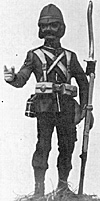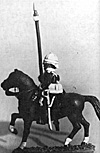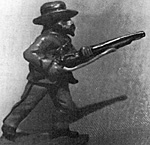Unlike the Zulu army, the British expeditionary force in Zululand is quite well documented. There is not space here to consider exhaustively the subtleties of uniform and equipment development in the years preceeding the war; for this readers are recommended to consult Weapons and Uniforms of the Zulu War by Chris Wilkinson-Latham, published in 1978 by Batsford, which is the most comprehensive account available to the wargamer. What follows, therefore, is little more than a painting guide, which will, I hope, be of some use to those preparing a miniature army.
INFANTRY
 Line: White sunhelmet, originally with brass plate. It was common, however, for soldiers with some experience of life on campaign to remove the badge and dye the helmet brown with tea or coffee. (At right, indantry sergeant's uniform: Tradition 54mm figure).
Line: White sunhelmet, originally with brass plate. It was common, however, for soldiers with some experience of life on campaign to remove the badge and dye the helmet brown with tea or coffee. (At right, indantry sergeant's uniform: Tradition 54mm figure).
Scarlet tunic, with pointed cuff patch and tabs on either side of collar and color of the regimental facing. White piping along the base of the collar, down front edge, up pleats at back and around cuff ending in trefoil design. A regimental badge was worn on the collar patch. Buttons were yellow metal. The facing colors for those Imperial regiments most prominent in the campaign were:
-
3rd Foot (The Buffs) Buff
13th Foot (Somerset L.l.) Blue
21st Foot Blue
24th Foot (2nd Warwickshire) Green
80th Foot Yellow
90th Foot Buff
91st Foot Yellow
For a full list, see the work mentioned above. Trousers were dark blue with a thin scarlet welt on the outside seam. Gaiters and boots were black. All equipment straps were originally white, though many were dyed buff or light brown. The water bottle was light brown. In full marching order the greatcoat was grey, the valise black, and the expense pouch containing ammunition worn below it also black. The bayonet scabbard was black leather.
Rifles: The 60th Rifles played a considerable part in the campaign, particularly during its latter stages. They wore dark green jacket and trousers with a single scarlet loop on the cuff and the strips down the outside leg. All equipment straps were black, and the greatcoat was often worn en banderole.
Highlanders: The 91st were the only Highland regiment in Zululand in 1879. Only the pipers wore the kilt, the others wore trews with Campbell of Cawdor tartan. Two types of tunic were worn, the doublet and the frock. The doublet had Inverness pockets or flaps beneath the waist, two at the front and two at the back.
These had three buttons with loops of braid running to them on each; white piping for Other Ranks, gold for officers. Cuffs were gauntlet type, each with three buttons and loops. Officers had gold piping around the collar and cuffs. The frock was simpler and appears to have been more common; this had a simple cutaway skirt in place of the pockets, and was faced on the collar only. It had gauntlet style cuffs. All other equipment was the same as for Line infantry, though the pouches were sometimes black leather.
CAVALRY
 Lancers: The 17th Lancers (at right, a Minifigs 25mm) played an
extensive part in the latter stages of the campaign. They
wore a white sunhelmet, which some contemporary
sketches suggest was sometimes dyed brown, though this
was frowned upon. The tunic was blue with white collar,
cuffs and piping down backseams, and a white plastron
front. This was often reversed to show its blue backing,
leaving a narrow white line down the left edge.
Lancers: The 17th Lancers (at right, a Minifigs 25mm) played an
extensive part in the latter stages of the campaign. They
wore a white sunhelmet, which some contemporary
sketches suggest was sometimes dyed brown, though this
was frowned upon. The tunic was blue with white collar,
cuffs and piping down backseams, and a white plastron
front. This was often reversed to show its blue backing,
leaving a narrow white line down the left edge.
Trousers were dark blue with a double white stripe. Officially the lancers were supposed to wear a yellow waist girdle with two crimson stripes, though there is evidence to suggest a plain white ammunition belt was worn in its place. The lance was bamboo with a red over white pennant and steel point and base.
Dragoons: The 1st (King's) Dragoon Guards wore a scarlet tunic with blue collar, cuffs and shoulder straps. Piping around the collar, down the front edge and around the cuff, ending in an Austrian knot, was yellow (gold for officers). Helmet was white, trousers blue with a thin yellow (ordinary ranks -- OR) or broad gold (officers) stripe, and all equipment straps white or buff leather.
ARTILLERY
The Royal Artillery wore a blue uniform with a white helmet, usually stripped of its brass ornaments and dyed brown. ORs uniform consisted of tunic with scarlet collar and piping down front, around bottom and up the pleats at the back. The collar was trimmed yellow, and there was a yellow trefoil on the blue cuffs. Shoulder straps were edged scarlet, with yellow grenade and brigade numbers. Trousers were blue with scarlet stripe. The Officer's tunic was similar, but with gold braid instead of yellow piping, and the trousers had a broader stripe.
Artillery officers -- like Infantry and Engineers -- often wore a blue patrol jacket instead of a tunic. This was plain blue, with black mohair braid down the front, around the cuffs and across the chest ending in loops -- like a Hussar jacket.
NAVAL BRIGADE
 The Navy contributed troops (at right Naval Brigade and Line Infantry 25mm Minifig) from several ships -- including HMS Shah and HMS Tenedos -- who took an active part in the campaign, particularly at the battle of Gingindhlovu. Several of Lord Chelmsford's gatling guns were manned by sailors. They seem to have worn a mixture of blues and whites; most common are blue trousers and shirt, with a wide sailor collar trimmed white. Straw hats with a blue band bearing the name of the wearer's ship around the crown were the order of the day, though white or blue caps seem to have been common. White canvas leggings were worn around the ankles and all equipment straps were brown leather.
The Navy contributed troops (at right Naval Brigade and Line Infantry 25mm Minifig) from several ships -- including HMS Shah and HMS Tenedos -- who took an active part in the campaign, particularly at the battle of Gingindhlovu. Several of Lord Chelmsford's gatling guns were manned by sailors. They seem to have worn a mixture of blues and whites; most common are blue trousers and shirt, with a wide sailor collar trimmed white. Straw hats with a blue band bearing the name of the wearer's ship around the crown were the order of the day, though white or blue caps seem to have been common. White canvas leggings were worn around the ankles and all equipment straps were brown leather.
Some sailors appear in photographs wearing white trousers and shirt or even white trousers and blue shirt! Officers wore a blue frock with gold rank insignia around the cuff, and either a white cap sometimes with a blue cover or a blue sunhelmet.
THE COLONIALS
The Natal Colonists provided several volunteer units most of which served with distinction throughout the campaign. The following is a list of those most prominant:
 The Frontier Light Horse: One of the most dashing and efficient of the volunteer cavalry units. At right, Frontier light horse converted from Minifig 25mm Boer figure. A wide brimmed hat with a red pugree was common to all; officers and NCOs wore a black cord uniform with a scarlet stripe in the trousers. The jacket was edged and frogged with black mohair braid. The ORs uniform was similar, but in light Khaki (buff) cord with black braid and a black stripe. Regular officers tended to regard the appearance of the FLH as 'piratical'. There is evidence to suggest that flamboyant extras such as scarlet bandanas, knee-length boots, and feathers in the hat were not unknown. They were draped around with bandoliers and wore a knife in the belt.
The Frontier Light Horse: One of the most dashing and efficient of the volunteer cavalry units. At right, Frontier light horse converted from Minifig 25mm Boer figure. A wide brimmed hat with a red pugree was common to all; officers and NCOs wore a black cord uniform with a scarlet stripe in the trousers. The jacket was edged and frogged with black mohair braid. The ORs uniform was similar, but in light Khaki (buff) cord with black braid and a black stripe. Regular officers tended to regard the appearance of the FLH as 'piratical'. There is evidence to suggest that flamboyant extras such as scarlet bandanas, knee-length boots, and feathers in the hat were not unknown. They were draped around with bandoliers and wore a knife in the belt.
The Natal Carabineers: Today one of the premiere units in the South African army, the Carbineers wore a white helmet and blue jacket and trousers in 1879. The helmet had a white metal chin chain and spike, and a simple badge composed of the letters NC. The tunic had white pointed cuffs and a white collar. The trousers had a white stripe and there was no waist belt. The crossbelts were brown leather, while the haversack on the left hip was of white canvas.
The Natal Mounted Police: The NMP wore a black cord uniform with simple black piping on the collar and cuffs and a white helmet with brass chinchain, spike and badge. There is some evidence to suggest the helmet was dyed, the cross straps either brown or black leather.
As explained in the introduction, the above list does not pretend to be complete. The colonial units particularly, were plentiful, small, and wore a variety of uniforms. For more detailed lists see the WilkinsonLatham book. A useful set of six postcards with colour pictures of Zulu war uniforms, including Colonials (but beware of the dubious Zulu details!), can be obtained from the National Army Museum, Royal Hospital Road, Chelsea, London, England.
Related
-
Zulu Firepower
Zulu Army Organization
Zulu Weapons and Uniforms
Native Levies in the Zulu War
Imperial Infantry Uniforms of the Zulu War
Zulu Roundup: Figures and Books
Back to Table of Contents -- Courier Vol. 1 #5
To Courier List of Issues
To MagWeb Master Magazine List
© Copyright 1980 by The Courier Publishing Company.
This article appears in MagWeb (Magazine Web) on the Internet World Wide Web.
Other military history articles and gaming articles are available at http://www.magweb.com